Integration of Electric Vehicles into the Electric Power System Based on Results of Road Traffic Census
Abstract
:1. Introduction
2. Literature Review
3. Estimation of EV Switching Potential in Japan
3.1. Road Traffic Census Vehicle Origin and Destination Survey
- Vehicle trip data that comprised of missing or mismatched departure/arrival times and trip mileage;
- Vehicles that drove over 150 km/h.
3.2. EV Travel Patterns and Electricity Consumption
3.3. EV Clustering
4. Production Cost Model Including EV Operation
- (1)
- Supply and demand balance:
- (2)
- Upper and lower limits on generator output:
- (3)
- Restriction on VRE upper and lower limits:
- (4)
- Interconnected power flow limits:
- (5)
- Capacity constraints on pumped storage reservoir:
- (6)
- Pumping input/output upper and lower limit constraints:
- (7)
- LFC capability restrictions:
- (8)
- Simultaneous constraints on pumping and power generation in pumped storage:
- (9)
- Pumped storage balance constraints:
- (10)
- LFC adjustment power supply upper/lower limits:
- (11)
- Upper and lower limits and balance constraints on LFC adjustment power:
- (12)
- Must-run unit constraints:
- (13)
- Maintenance constraints:
- (14)
- EV battery balance:
- (15)
- EV charging and discharging control constraints:
- Charging upper limits for charging control only (only operated EV batteries are used):
- Charging upper limits for charging and discharging control (all EV batteries are used):
- Discharging upper limits in charging and discharging control (all EV batteries are used):
- (16)
- EV SOC constraints:
- Required SOC at time t (this is the SOC that exceeds the fleet demand and charge/discharge amount after time t − 1):
- conditions for SOC:
- EV SOC upper and lower limits:
5. Simulation
5.1. Simulation Conditions
5.1.1. Available Generators and Electricity Demand
5.1.2. Hourly Profile of Electricity Demand and VRE Generation
5.1.3. Available LFC Supply Capacity, Required LFC Capacity for VRE, and Demand Fluctuation
5.1.4. Interconnection
5.1.5. EVs
5.2. Simulation Cases
- Case 0.
- No EV cases
- Case 1.
- At-home dumb-charging case
- Case 2.
- Charging control at home only
- Case 3.
- Charging control at home and at the workplace
- Case 4.
- Charging and discharging control at home only
- Case 5.
- Charging and discharging control at home and at the workplace
5.3. Simulation Results
5.3.1. Electricity Generation
5.3.2. Operational Costs
5.3.3. Reduction in VRE Curtailment
5.3.4. CO2 Emissions
5.3.5. Daily Operations
6. Conclusions
- -
- Japanese vehicles travel shorter distances, with nearly half of all vehicles being unused on a daily basis, based on a 2010 OD survey. As a future scenario, assuming that the ratio of non-operating vehicles is half that found in 2010, the travel mileage per vehicle equaled 7,468 km per year, which was less than half of that found for EVs in the US. Therefore, the charge control method could not be used to make EV batteries contribute to the grid. Both charging and discharging control did allow the batteries of non-operating vehicles to be utilized, which led to an increase in the control potential.
- -
- The introducing of EVs to a point where they constituted 16% of all private cars in 2030 increased the nationwide electric power system demand by 0.7%. As the control amount for EVs increased, the curtailment of VRE was reduced, the overall power generation of pumped storage and natural gas decreased, while the use of inexpensive coal increased. The introduction of EVs increased the generation costs in a dumb-charging scenario, however, in that the application of charge to an EV battery could reduce the incremental cost by 31%–40%, while the charge/discharge control could reduce it by 54%–71%.
- -
- A 17% curtailment in VRE occurred without the introduction of EVs. Here, the curtailment was reduced by 0.7% in the dumb-charging case, by 4.6–7.7% for the charge control only case, and by 13.9–18.1 % in the case when both charge and discharge controls are applied.
- -
- Since CO2 emissions were not restricted in this simulation, the CO2 release increased slightly through the application of charge and discharge controls when operational costs were minimized. However, due to the effect of fossil fuel substitution with the adoption of EVs, the CO2 emissions were reduced by 10–11 Mt per year.
- -
- The control effects of EVs were restricted by the kW capacity (3 kW). It was, therefore, suggested that greater control effects could be attained by increasing the inverter capacity for the charge and discharge scenarios. An increase in the kWh capacity (40 kWh) did not lead to an increase in the effect under this assumption.
Author Contributions
Funding
Acknowledgments
Conflicts of Interest
Nomenclature
| Index | |
| t | Time slot |
| i | Generator unit |
| ig | Grid |
| m | Interconnection line |
| c | Electric vehicle (EV) cluster |
| imustrun | Index of must-run generator units |
| imuststop | Index of must-stop generator units |
| imainte | Index of generator units under maintenance |
| Parameters | |
| bi, ci | Coefficients |
| NT | Number of time slots |
| Ngrid | Number of grids |
| NGig, idxig | Total number and initial index of generator units in grid ig |
| NPGig, idpig | Total number and initial index of pumped storage units in grid ig |
| NTGig, idtig | Total number and initial index of thermal and nuclear generator units in grid ig |
| NHGig, idhig | Total number and initial index of hydro, geothermal and biomass generator units in grid ig |
| Ntgig | Set of thermal generators and nuclear generator units in grid ig |
| Nhgig | Set of hydro, geothermal and biomass generator units in grid ig |
| LOADigt | System load at time t in grid ig |
| PLi, PUi, adjpui | Lower and upper output and adjustment ratio of generator unit i |
| PsLi, PsUi | Lower and upper water storage capacity of pumped storage unit i |
| PgLi, PgUi, adjpgi | Lower and upper output and adjustment ratio of pumped storage unit i |
| PpLi, PpUi, adjppi | Lower and upper input and adjustment ratio of pumped storage unit i |
| ηi | Pumping efficiency of pumped water generator unit i |
| Npf | Number of interconnection lines |
| Npfig, from, Npfig, to | Set of grids that are from side and to side connected with grid ig via interconnection lines |
| PfGUig, PfGLig | Upper and lower limit flow via interconnection lines connected to grid ig |
| PfUm, PfLm | Upper and lower limit flow in interconnection line m |
| mrgm | Marginal capacity in interconnection line m |
| lossm | Transmission loss in interconnection line m |
| BTig, adjbtig | Battery capacity and adjustment ratio in grid ig |
| orloadig, orpvig, orwdig | Required adjustment ratio for system load, photovoltaic (PV) generation and wind power generation in grid ig |
| NEVig | Number of EV cluster of grid ig |
| EVhomeig,ct | EV chargeable capacity at time t in cluster c of grid ig |
| EVhome2ig,ct | EV chargeable and dischargeable capacity at time t in cluster c of grid ig |
| EVloadig,ct | EV fleet load at time t in cluster c of grid ig |
| ηCh | EV battery efficiency |
| BTcapmaxig,c | Maximum EV battery capacity in cluster c of grid ig |
| BTcapminig,c | Minimum EV battery capacity in cluster c of grid ig |
| Variables | |
| Pit | Outputs of generator i at time t |
| Uit | Unit commitment states of generator unit i at time t (0stop, 1start) |
| Ugi,ig, Upi,ig | Unit commitment states of pumped storage unit i in grid ig (0stop, 1start) |
| Upit | Unit commitment states for pumping of pumped storage unit i at time t in generator i (0stop, 1start) |
| Ugit | Unit commitment states for generating of pumped storage unit i at time t in generator i (0stop, 1start) |
| Psi t | Water storage amount of pumped storage unit i at time t |
| Ppit, Pgit | Pumping input and output amount of pumped storage unit i at time t |
| Phit, adjhi | Output and adjustment ratio of hydropower unit i at time t |
| Pcgigt, adjcgig | Output and adjustment ratio of co-generation system at time t in grid ig |
| Ppvigt,Pwdigt | Output of PV and wind power systems at time t in grid ig |
| SVpvigt, SVwdigt | Curtailment of PV and wind power systems at time t in grid ig |
| Pfmt | Power flow on interconnection line m |
| LFCsendigt | LFC (load frequency control) power from grid ig to other grids |
| LFCreceiveigt | LFC power from other grids to grid ig |
| LFCupit | LFC reserve capacity to raise at time t in generator unit i |
| LFCdownit | LFC reserve capacity to lower at time t in generator unit i |
| EVchig,ct | EV charging amount for EV fleet at time t in cluster c of grid ig |
| EVochig,ct | EV charging amount for other than EV fleet at time t in cluster c of grid ig |
| Dischig,ct | EV discharging amount at time t in cluster c of grid ig |
| EVsocig,ct | EV state of charge (SOC) at time t in cluster c of grid ig |
References
- The Ministry of the Environment Japan’s National Greenhouse Gas Emissions in Fiscal Year 2017. Available online: https://www.env.go.jp/press/files/en/784.pdf (accessed on 14 May 2019).
- Automobile Inspection & Registration Information Association Vehicle Ownership Trend in Japan. Available online: https://www.airia.or.jp/publish/statistics/trend.html (accessed on 14 May 2019). (In Japanese).
- Richardson, D.B. Electric vehicles and the electric grid: A review of modeling approaches, impacts, and renewable energy integration. Renew. Sustain. Energy Rev. 2013, 19, 247–254. [Google Scholar] [CrossRef]
- Liu, L.; Kong, F.; Liu, X.; Peng, Y.; Wang, Q. A review on electric vehicles interacting with renewable energy in smart grid. Renew. Sustain. Energy Rev. 2015, 51, 648–661. [Google Scholar] [CrossRef]
- Hu, J.; Morais, H.; Sousa, T.; Lind, M. Electric vehicle fleet management in smart grids: A review of services, optimization and control aspects. Renew. Sustain. Energy Rev. 2016, 56, 1207–1226. [Google Scholar] [CrossRef] [Green Version]
- Daina, N.; Sivakumar, A.; Polak, J.W. Modelling electric vehicles use: a survey on the methods. Renew. Sustain. Energy Rev. 2017, 68, 447–460. [Google Scholar] [CrossRef] [Green Version]
- Lyon, T.P.; Michelin, M.; Jongejan, A.; Leahy, T. Is “smart charging” policy for electric vehicles worthwhile? Energy Policy 2012, 41, 259–268. [Google Scholar] [CrossRef]
- Camus, C.; Farias, T.; Esteves, J. Potential impacts assessment of plug-in electric vehicles on the Portuguese energy market. Energy Policy 2011, 39, 5883–5897. [Google Scholar] [CrossRef]
- Fernandes, C.; Frías, P.; Latorre, J.M. Impact of vehicle-to-grid on power system operation costs: The Spanish case study. Appl. Energy 2012, 96, 194–202. [Google Scholar] [CrossRef]
- Wang, J.; Liu, C.; Ton, D.; Zhou, Y.; Kim, J.; Vyas, A. Impact of plug-in hybrid electric vehicles on power systems with demand response and wind power. Energy Policy 2011, 39, 4016–4021. [Google Scholar] [CrossRef]
- Dallinger, D.; Gerda, S.; Wietschel, M. Integration of intermittent renewable power supply using grid-connected vehicles—A 2030 case study for California and Germany. Appl. Energy 2013, 104, 666–682. [Google Scholar] [CrossRef]
- Tan, Z.; Yang, P.; Nehorai, A. An Optimal and Distributed Demand Response Strategy with Electric Vehicles in the Smart Grid. IEEE Trans. Smart Grid 2014, 5, 861–869. [Google Scholar] [CrossRef]
- Saber, A.; Venayagamoorthy, G. Resource cheduling under uncertainty in a smart grid with renewables and plug-in vehicles. IEEE Syst. J. 2012, 6, 103–109. [Google Scholar] [CrossRef]
- California Energy Commission. California Plug-in Electric Vehicle Infrastructure Projections 2017–2025; California Energy Commission: Sacramento, CA, USA, 2018.
- Zhang, Q.; Tezuka, T.; Ishihara, K.N.; Mclellan, B.C. Integration of PV power into future low-carbon smart electricity systems with EV and HP in Kansai Area, Japan. Renew. Energy 2012, 44, 99–108. [Google Scholar] [CrossRef]
- Yabe, K.; Shinoda, Y.; Seki, T.; Tanaka, H.; Akisawa, A. Market penetration speed and effects on CO2 reduction of electric vehicles and plug-in hybrid electric vehicles in Japan. Energy Policy 2012, 45, 529–540. [Google Scholar] [CrossRef]
- The Ministry of Land, Infrastructure and Transport Road Traffic Census Vehicle Origin and Destination Survey. Available online: http://www.mlit.go.jp/road/h27road-od/od1.html (accessed on 14 May 2019). (In Japanese).
- Arthur, D.; Vassilvitskii, S. k-means++: the advantages of careful seeding. In Proceedings of the Eighteenth Annual ACM-SIAM Symposium on Discrete Algorithms; Society for Industrial and Applied Mathematics Philadelphia: Philadelphia, PA, USA, 2007; pp. 1027–1035. [Google Scholar]
- Azuma, H.; Ogimoto, K.; Fukutome, S.; Minotsu, S. Impacts of asset investment of renewable energy on market design and operation. In Proceedings of the CIGRE 2016, Paris, France, 21–26 August 2016. [Google Scholar]
- Gurobi Gurobi Optimizer 8.1. Available online: http://www.gurobi.com/ (accessed on 14 May 2019).
- Ministry of Economy, Trade and Industry Long-Term Energy Supply and Demand Outlook 2015. Available online: https://www.meti.go.jp/english/press/2015/pdf/0716_01a.pdf (accessed on 14 May 2019).
- Electric Power Research Institute Electric Vehicle Driving, Charging, and Load Shape Analysis a Deep Dive into Where, When, and How Much Salt River Project (SRP) Electric Vehicle Customers Charge. Available online: http://mydocs.epri.com/docs/PublicMeetingMaterials/ee/000000003002013754.pdf (accessed on 14 May 2019).
- Ministry of Land, Infrastructure and Transport Automobile Fuel Consumption Survey. Available online: http://www.mlit.go.jp/k-toukei/nenryousyouhiryou.html (accessed on 14 May 2019).
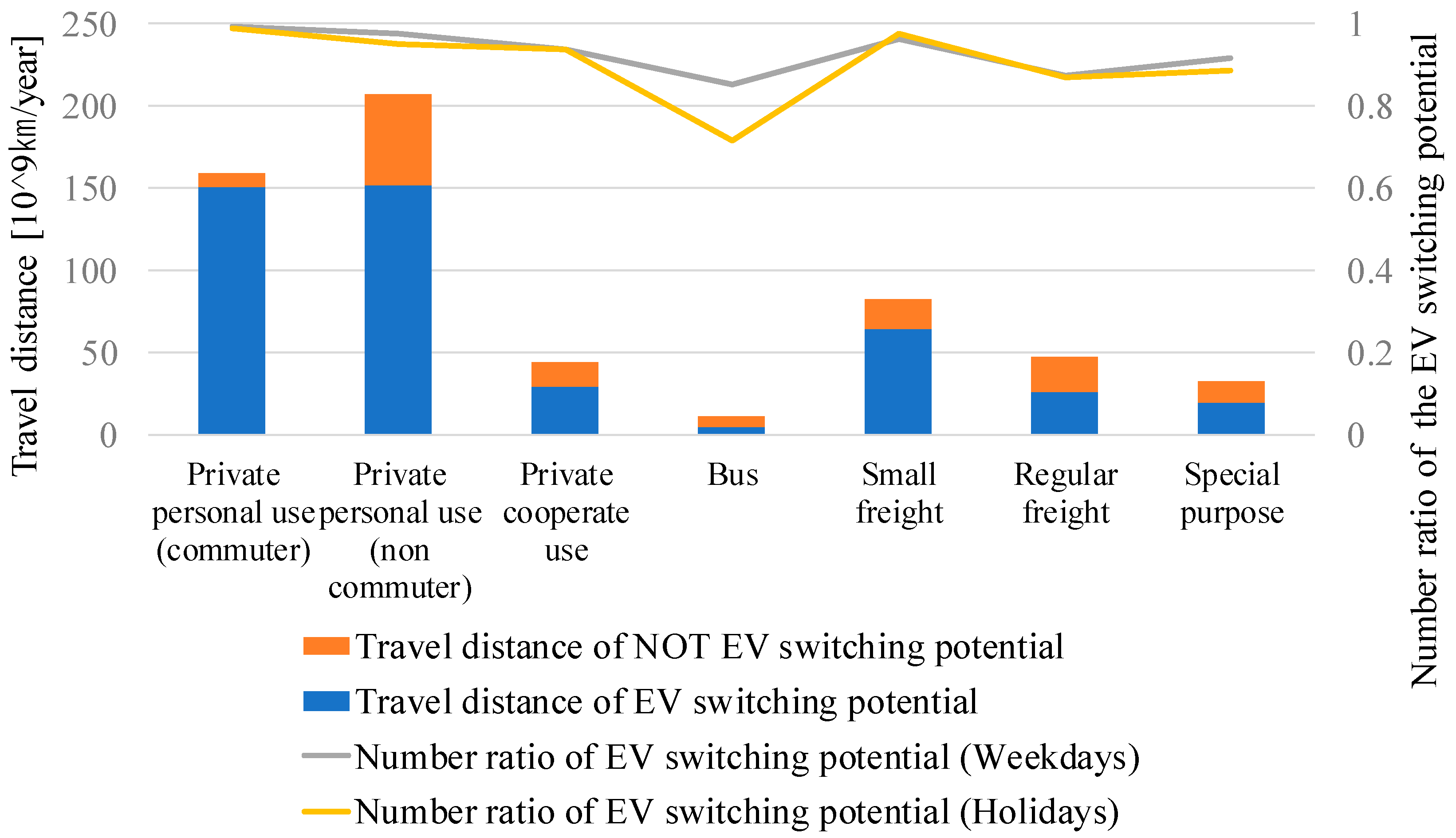
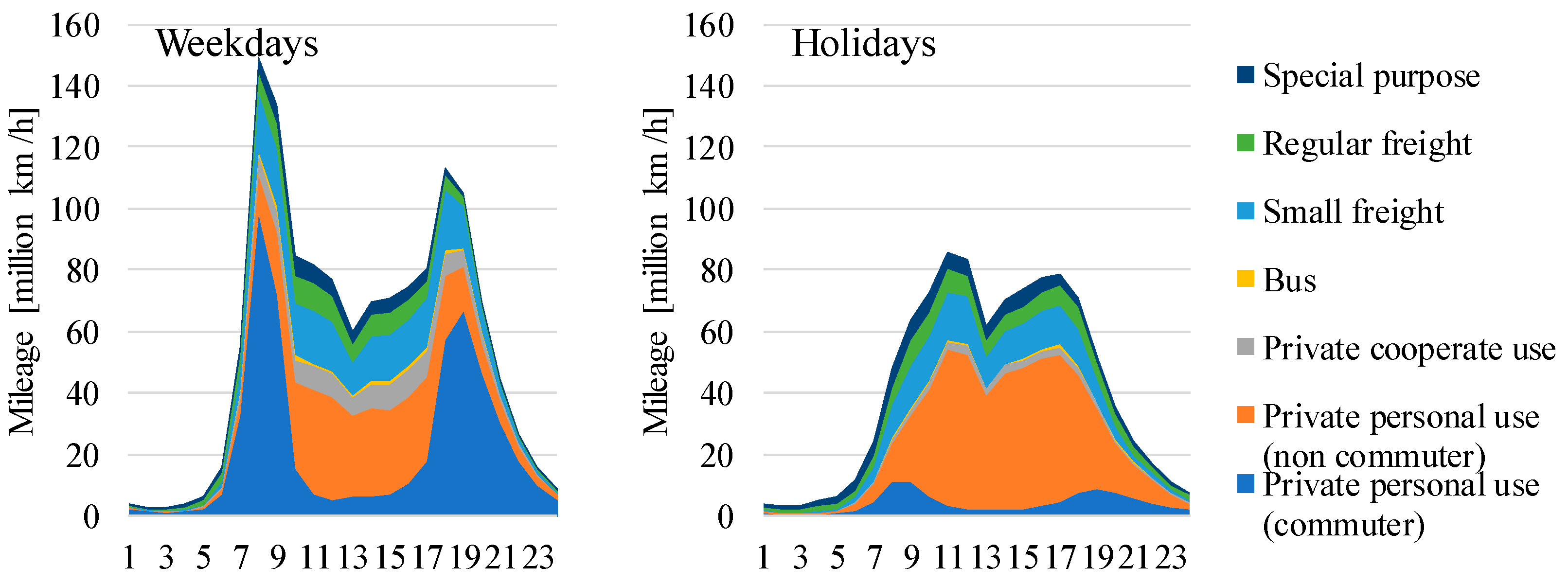
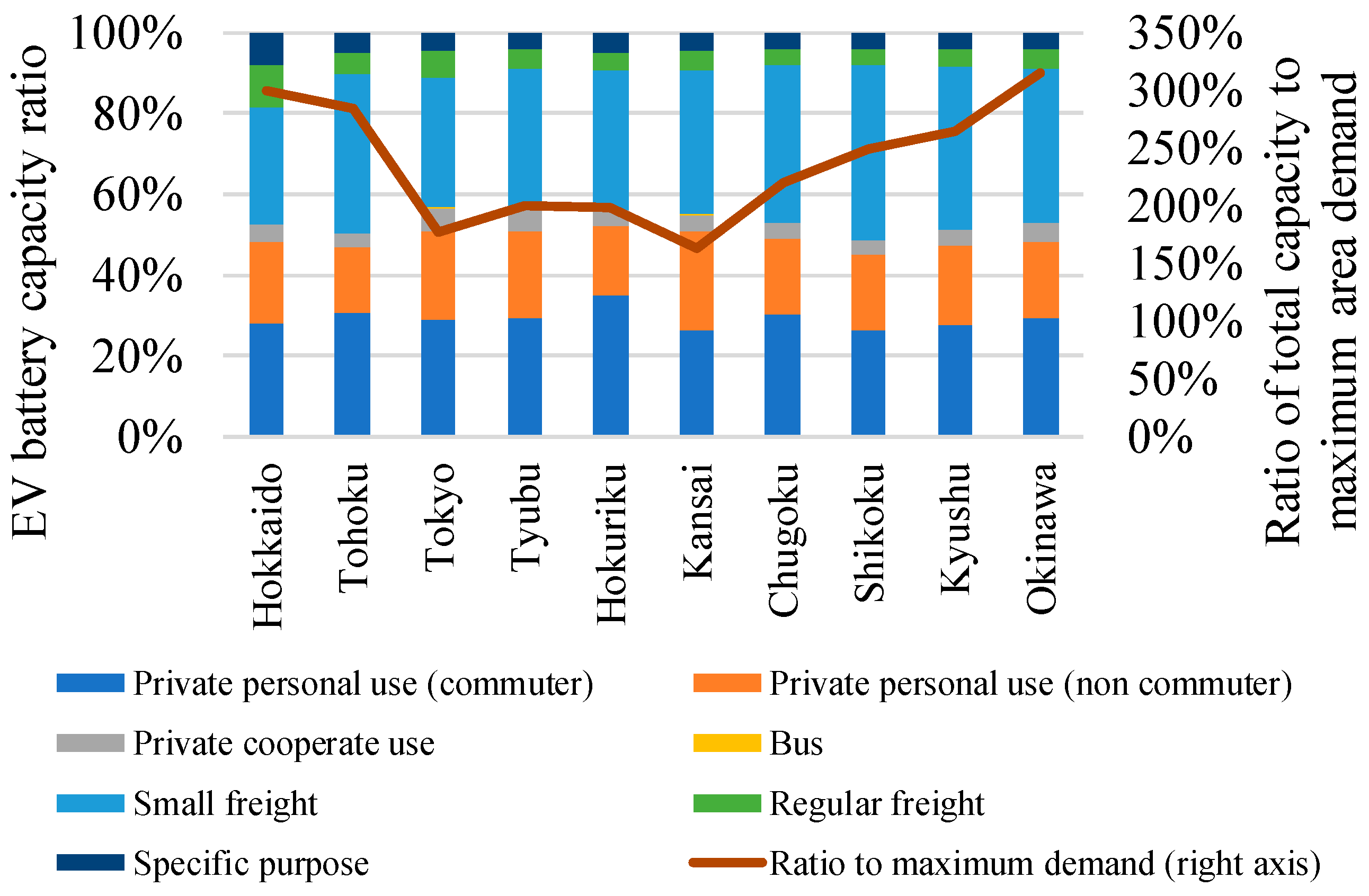



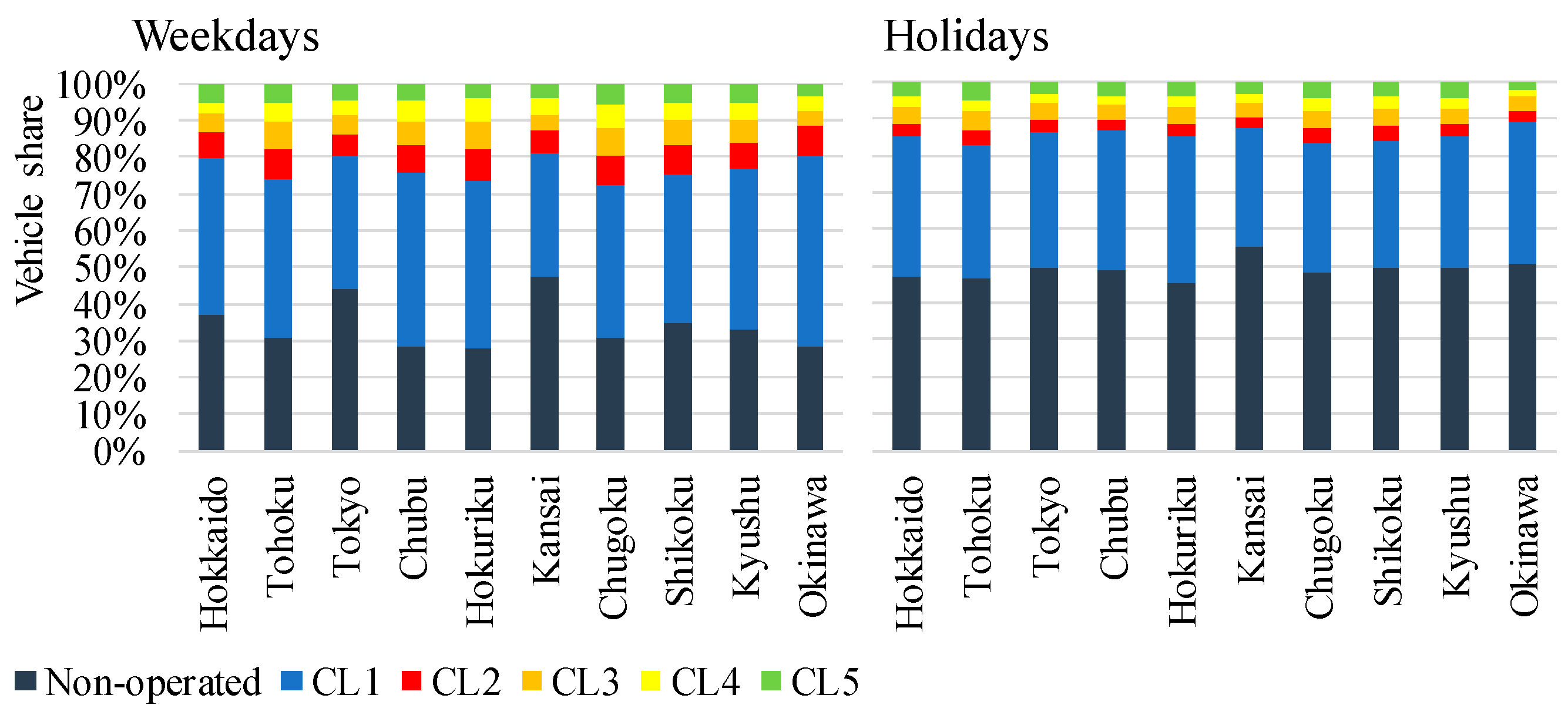
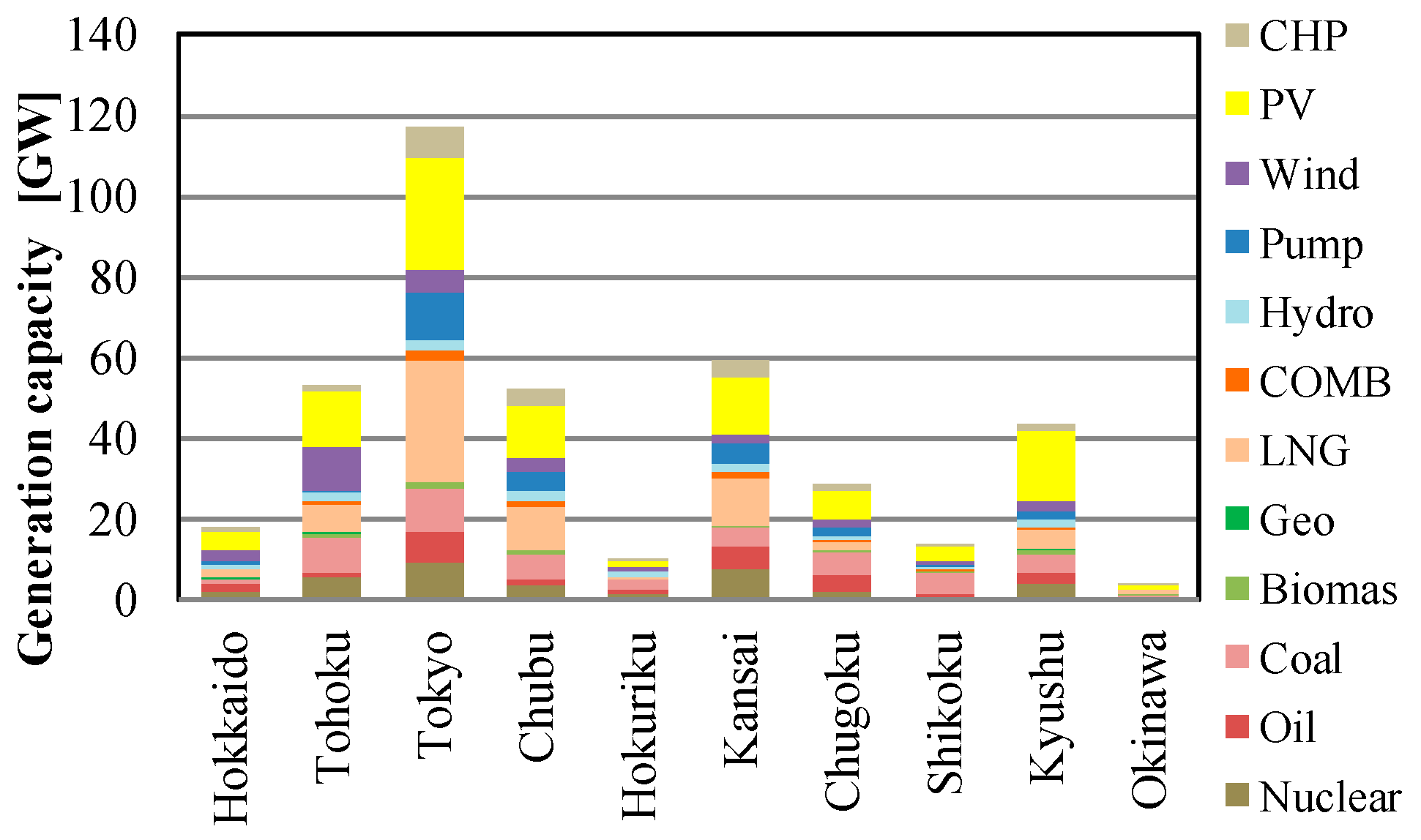


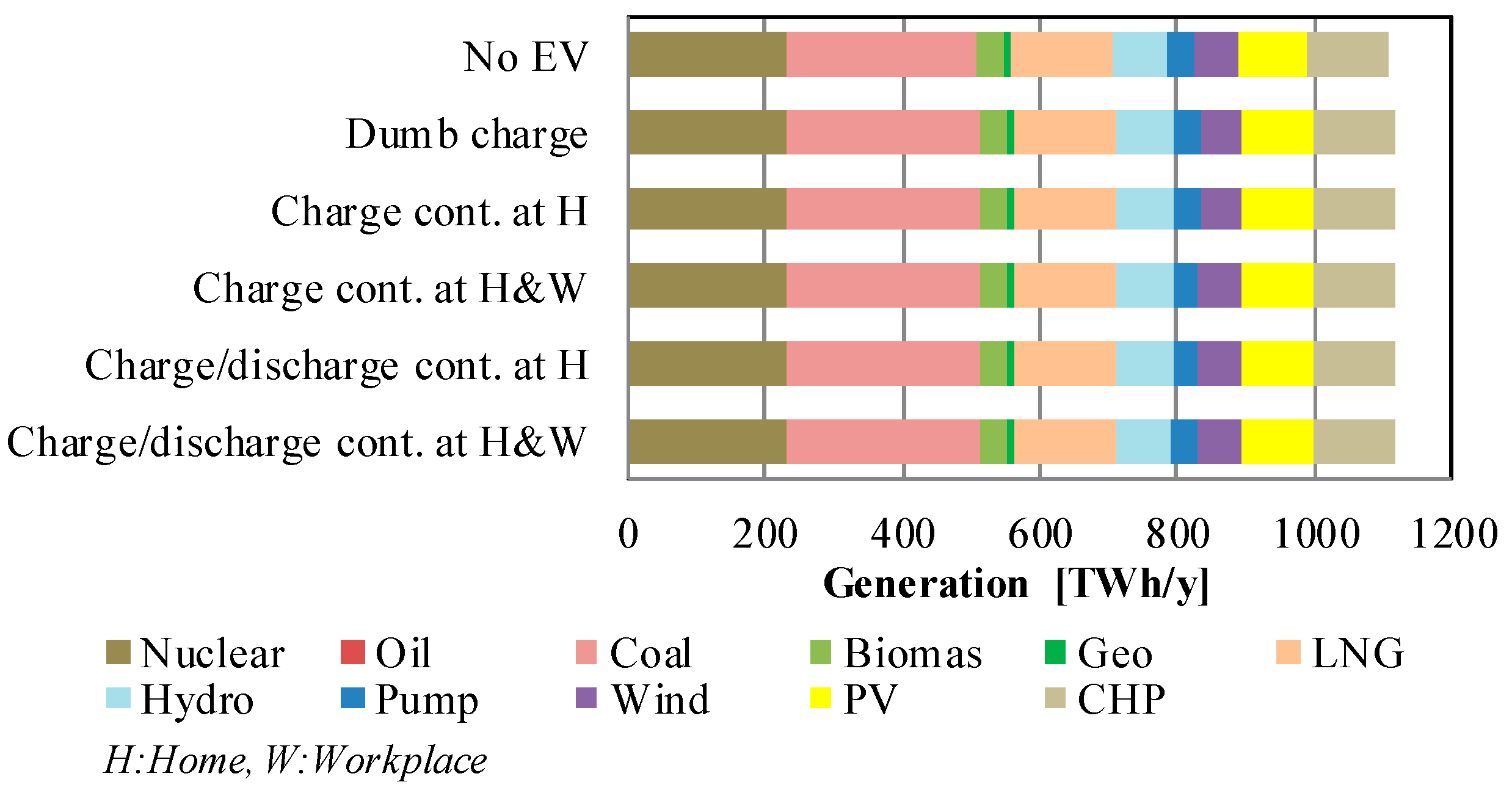



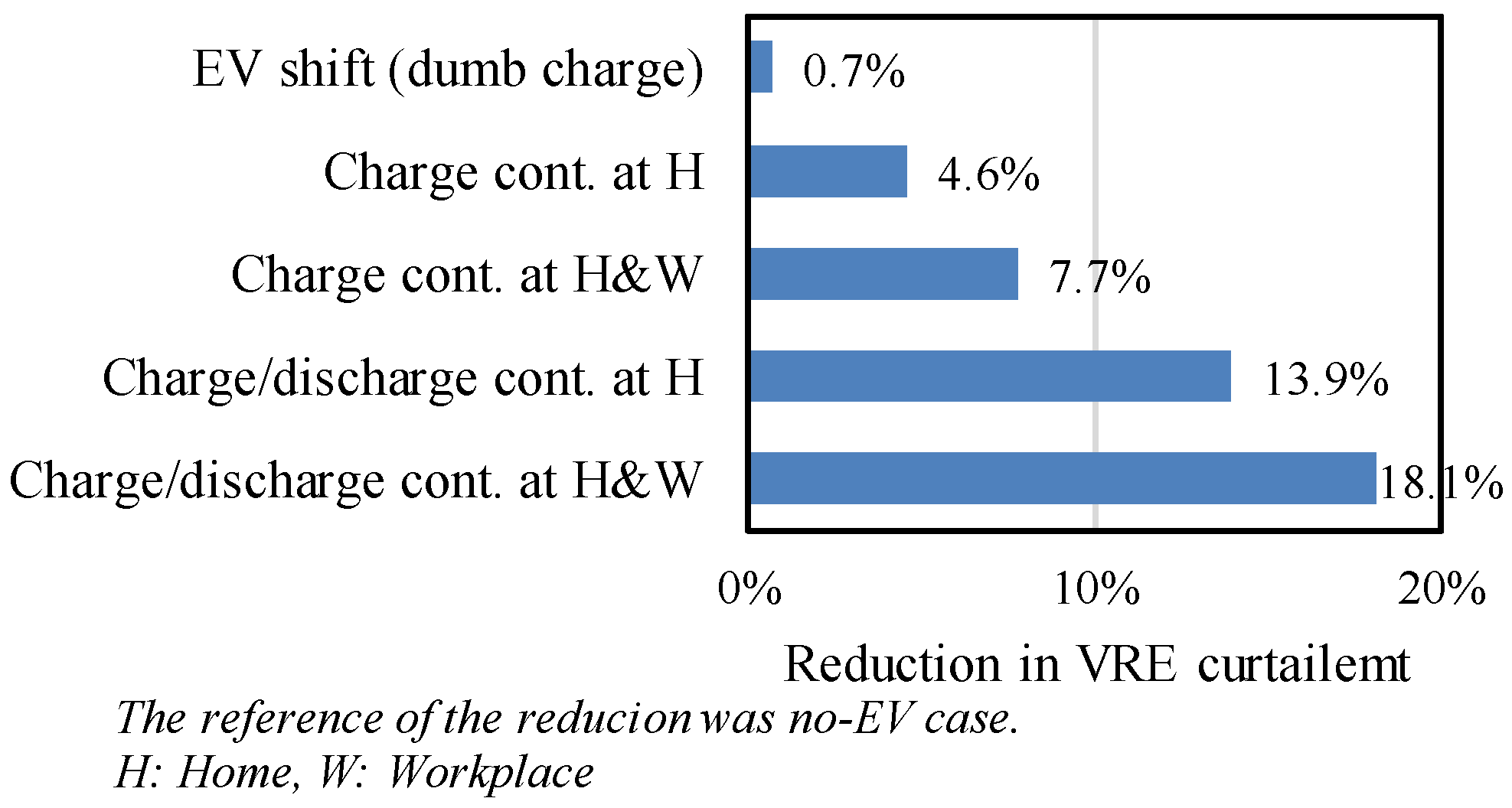
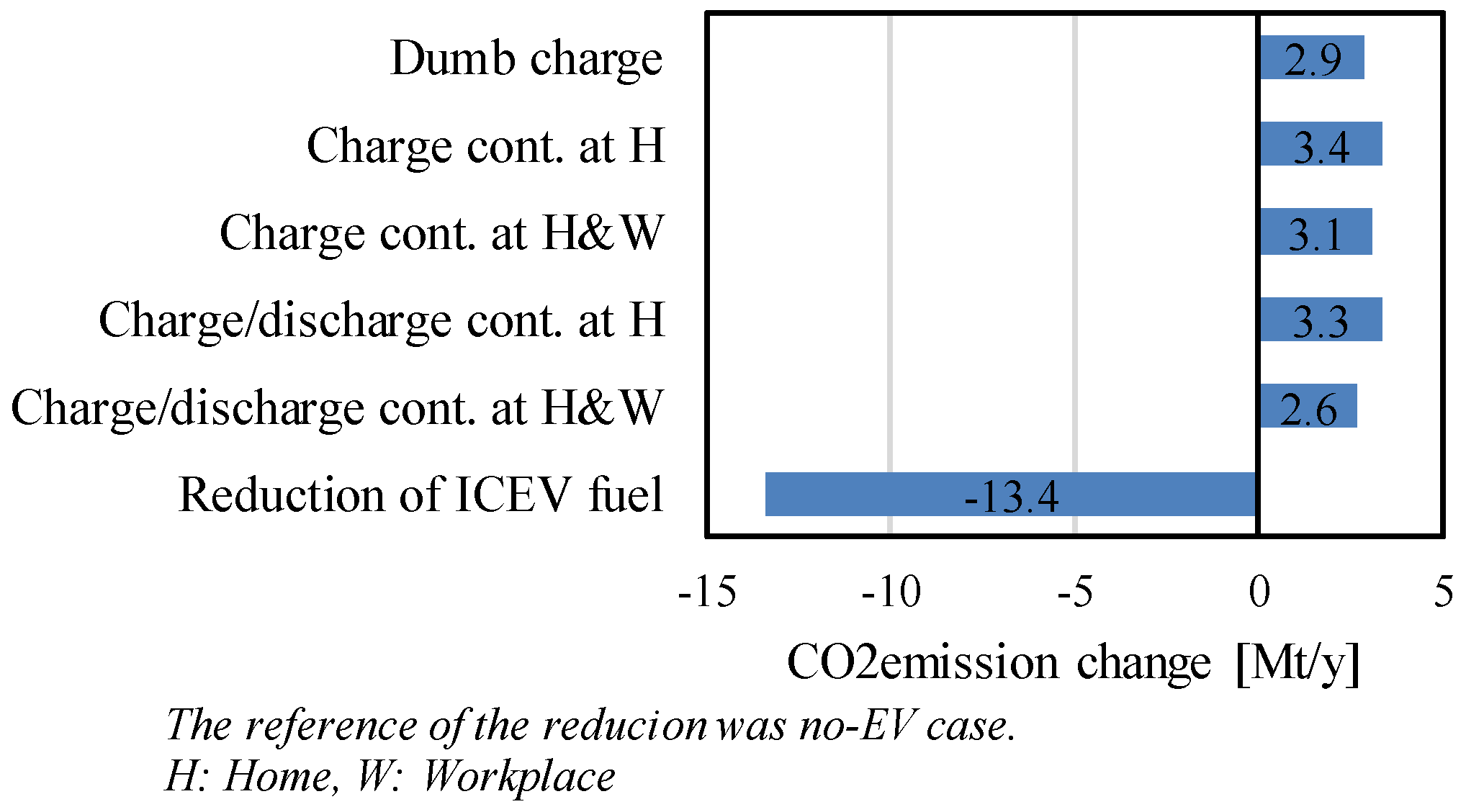
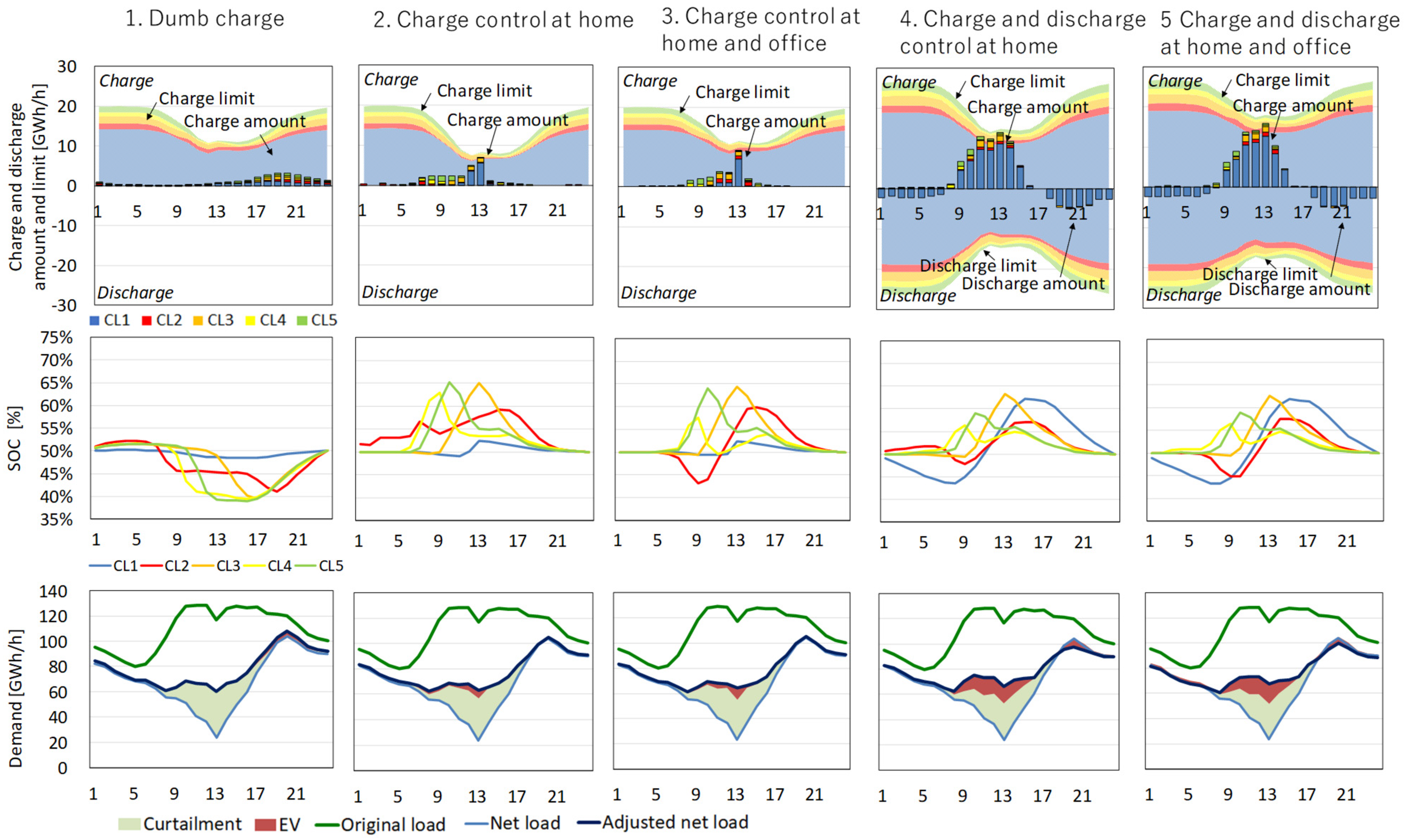
| Vehicle Types in the OD Survey | Vehicle Types in this Paper |
|---|---|
| Private light passenger vehicle | Private personal use vehicle (commuting, non-commuting) Private and corporate use vehicles |
| Private passenger vehicle | |
| Bus | Bus |
| Light truck | Small freight vehicle |
| Small freight vehicle | |
| Regular freight vehicle | Regular freight vehicle |
| Special purpose vehicle | Special purpose vehicle |
| From | To | Energy Exchange Capacity | |
|---|---|---|---|
| Send | Receive | ||
| Hokkaido | Tohoku | 810 | 810 |
| Tohoku | Tokyo | 4455 | 585 |
| Tokyo | Chubu | 1890 | 1890 |
| Chubu | Hokuriku | 270 | 270 |
| Chubu | Kansai | 1656 | 2250 |
| Hokuriku | Kansai | 1440 | 1170 |
| Kansai | Chugoku | 2430 | 3600 |
| Kansai | Shikoku | 1260 | 1260 |
| Chugoku | Shikoku | 1080 | 1080 |
| Chugoku | Kyushu | 495 | 2331 |
| Item | Case 0 | Case 1 | Case 2 | Case 3 | Case 4 | Case 5 |
|---|---|---|---|---|---|---|
| Operational costs (US$ billion/y) | 46,439 | 47,529 | 47,195 | 47,094 | 46,936 | 46,751 |
| VRE curtailment ratio (%) | 17.2 | 17.1 | 16.4 | 15.8 | 14.8 | 14.1 |
| CO2 emissions (Mt/year) | 309.2 | 312.0 | 312.5 | 312.2 | 312.5 | 311.8 |
© 2019 by the authors. Licensee MDPI, Basel, Switzerland. This article is an open access article distributed under the terms and conditions of the Creative Commons Attribution (CC BY) license (http://creativecommons.org/licenses/by/4.0/).
Share and Cite
Iwafune, Y.; Ogimoto, K.; Azuma, H. Integration of Electric Vehicles into the Electric Power System Based on Results of Road Traffic Census. Energies 2019, 12, 1849. https://doi.org/10.3390/en12101849
Iwafune Y, Ogimoto K, Azuma H. Integration of Electric Vehicles into the Electric Power System Based on Results of Road Traffic Census. Energies. 2019; 12(10):1849. https://doi.org/10.3390/en12101849
Chicago/Turabian StyleIwafune, Yumiko, Kazuhiko Ogimoto, and Hitoshi Azuma. 2019. "Integration of Electric Vehicles into the Electric Power System Based on Results of Road Traffic Census" Energies 12, no. 10: 1849. https://doi.org/10.3390/en12101849




